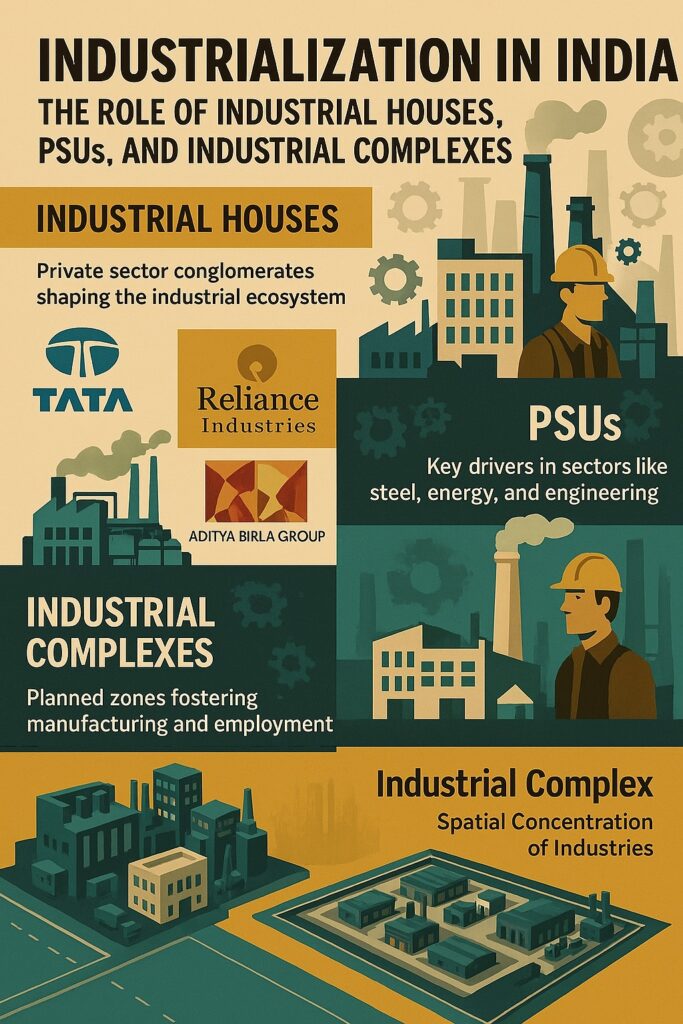Industrialization is a key driver of economic growth, and in India, both industrial houses and public sector undertakings (PSUs) play a significant role in shaping the industrial landscape. These entities are often organized into industrial complexes, which are spatial concentrations of industrial activities.

Table of Contents
1. Industrial Houses
Industrial houses refer to large business conglomerates that control multiple companies across different sectors of the economy. They are typically family-owned or privately managed corporate entities. These houses played a crucial role in India’s post-independence industrialization, especially during the mixed economy phase.
Key Features:
- Owned and operated by private entrepreneurs or families.
- Diversified business interests: textiles, steel, automobiles, chemicals, etc.
- Often integrated with finance, media, and infrastructure.
- Have national and global presence.
Examples in India:
- Tata Group – steel, automobiles, IT, telecom.
- Birla Group – cement, textiles, education, financial services.
- Reliance Industries – petrochemicals, retail, telecom, energy.
2. Industrial Complexes
An industrial complex refers to a spatially concentrated area where several industries operate in close proximity. These complexes may include both public and private industries, often sharing infrastructure like transportation, power, and water supply.
Key Features:
- Located near raw material sources or transport hubs.
- Includes ancillary industries and supporting services.
- Promotes economies of scale and regional development.
- Can lead to urbanization and growth of industrial towns.
Examples in India:
- Jamshedpur – Centered around Tata Steel.
- Bhilai – Steel plant complex with supporting engineering industries.
- Chennai Industrial Belt – Automobiles, electronics, IT.
3. Public Sector Undertakings (PSUs)
PSUs are government-owned corporations established to develop key industries, especially those critical for national security, infrastructure, and balanced regional development. After independence, PSUs formed the backbone of India’s planned industrial development.

Key Features:
- Fully or majority-owned by the government (central or state).
- Aim to provide goods/services, generate employment, and promote equity.
- Operate in core sectors: steel, coal, power, heavy machinery, oil.
Types:
- Maharatna: Large PSUs with significant global operations (e.g., ONGC, SAIL).
- Navratna: Medium-sized, high-performing PSUs (e.g., BEL, GAIL).
- Miniratna: Smaller but profitable enterprises (e.g., BSNL, HAL).
Geographical Implications
- Location Factors: Availability of raw materials, labor, market access, infrastructure, and policy incentives influence the siting of industrial houses and complexes.
- Urbanization: Industrial hubs often give rise to industrial towns and cities.
- Environmental Impact: Industrial clusters may lead to pollution, deforestation, and land degradation if not managed sustainably.
- Regional Disparities: Industrial growth is often concentrated in specific states (e.g., Maharashtra, Gujarat, Tamil Nadu), leading to uneven regional development.
Conclusion
Industrial houses and public sector undertakings together form the core of India’s industrial sector. While private industrial houses bring innovation, efficiency, and investment, PSUs serve strategic, developmental, and welfare-oriented roles. Their spatial clustering in the form of industrial complexes significantly influences the economic geography of India.
Read: Geography Notes